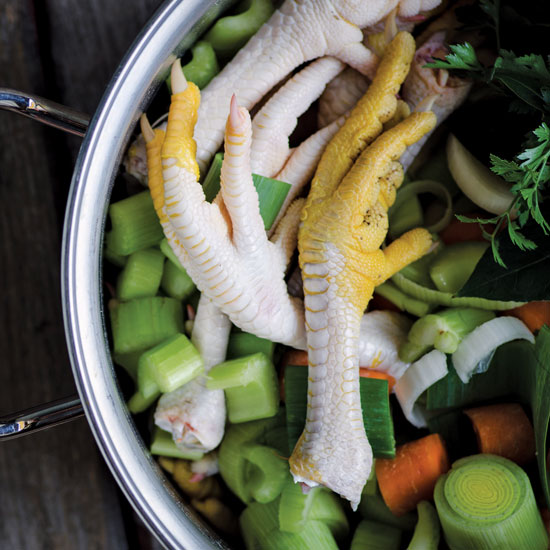Whenever our local rancher processes chickens, I arrive with bags in hand, not for the whole chickens, but to ask for the feet, lest they feed them to the dogs. Chicken feet have very little marketable value. Gnarly and doubtlessly repulsive with their scaly yellow skin and sharp talons, they nevertheless make the best broth. As with other odd cuts of meat, it’s easy to cast off the humble chicken foot, but in allowing squeamishness to get the better of you, you also miss out on the powerful nourishment and deep flavor they lend to broth, soups, and sauces.
Chicken feet are an extraordinary source of amino acids, particularly collagen, which is why chicken feet broth gels so readily. Its flavor is rich and concentrated, but somehow still delicate.

Ingredients:
- 3 pounds chicken feet, scrubbed very well
- 1 yellow onion, chopped
- 1 large leek, root tip removed, white and green parts thinly sliced
- 4 ribs celery, chopped
- 3 carrots, chopped
- 1 tablespoon whole black peppercorns
- 2 sprigs thyme
- 6 to 8 sprigs flat-leaf parsley
- 2 bay leaves
- 1/4 cup white wine
- 4 to 6 quarts cold water, plus more as needed
Instructions:
1. If necessary, peel away and discard any yellow membrane that adheres to the chicken feet, then chop off the claws. (The process of defeathering chickens often removes that yellow membrane; however, if it remains, it — and the talons — can create off flavors in the broth.)
2. Combine the chicken feet, onion, leek, celery, carrots, peppercorns, thyme, parsley, bay leaves, and wine in a large, heavy stockpot.
3. Cover the chicken feet and other ingredients with the water.
4. Bring to a boil over medium-high heat, then immediately decrease the heat to medium-low, cover, and simmer for 8 to 12 hours, adding water as necessary to keep the feet submerged. From time to time, skim away any scum that might rise to the surface.
5. Strain the broth, discarding the solids, then pour it into jars, cover, and store it in the refrigerator for up to 1 week or freeze it for up to 6 months. With chilling, the broth should gel enough that it must be scooped out of the jar with a spoon. This is normal, and the broth will liquefy once you heat it. A thin layer of yellow fat may harden on the surface of the gelled broth; I recommend discarding this fat, as it doesn’t lend itself to cooking.
Want more from The Nourished Kitchen? Read A Traditional Foods Movement: The Balance of Healthy Eating.
Reprinted with permission from The Nourished Kitchen written and photographed by Jennifer McGruther (Ten Speed Press, © 2014). Purchase this book from our store: The Nourished Kitchen.













